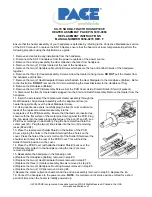
9
Photocell/Photo Slave:
The sensor is built-in and can be shut off by plugging in the sync cord.
Flash Power Bracketing:
Bracketing refers to taking up to three (3) exposures in a sequence with different
flash intensities, either additional watt seconds or fewer watt seconds, from the
displayed or selected “primary” base intensity. The Solair units enable you to
set the base flash power and then one high and one low bracketing values. Once
the setting(s) have been pre-set, a sequence of power levels will automatically
occur as you take the exposures. If you wish to only bracket up from the
primary, set a HIGH value and leave the LOW value at “0”. If you wish to only
bracket down from the primary, set the HIGH value at “0” and set a LOW value.
The 3-exposure bracketing sequence is:
1.
Primary power setting.
2.
Higher power pre-set.
3.
Lower pre-set.
The 2-exposure bracketing sequence is:
1.
Primary power setting.
2.
Either Higher or Lower (skips the “0” settings)
To set or change the Auto-Bracketing settings:
1.
Press the Auto-Bracketing button 3 times. This will cause the
display to read “br”, then H. .0
2.
Press the small up or down (1/10) button to set the HIGH value.
The values can be set at zero “0” to “1.5” f-stops above the
primary power setting.
3.
Press the large up (1/2) button once. This will cause the display to
read “L. .0
4.
Press the small down or up (1/10) button to set the LOW value.
The values can be set at zero “0” to “1.5” f-stops below the
primary power setting.
5.
Press the AUTO-BRACKET button to save these pre-sets.
To turn
off
the Auto-Bracketing settings:
Setting both the HIGH and the LOW values at zero “0” will turn off the Auto-
Bracket feature.
Note: The auto-bracketing settings are retained and sequenced until the feature
is manually turned off. If the primary power setting is changed the Auto-
Bracketing feature will continue to sequence using the pre-set HIGH and LOW
values from the new primary level.
(This bracketing feature is limited by the 8 f-stops of total watt seconds
available in each model.)










































